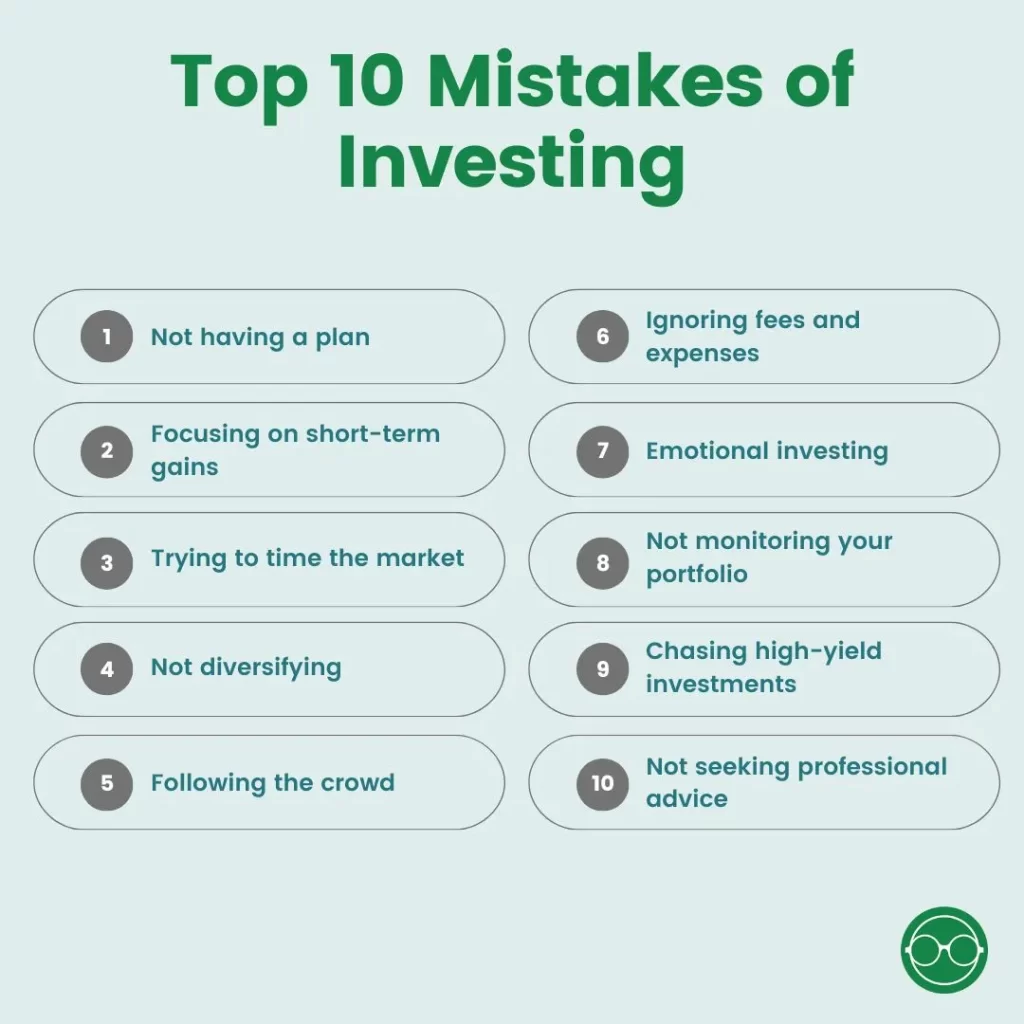This post may contain affiliate links. We may receive compensation when you click on links to those products at no additional cost to you. Read our full disclosure here.
When I started my investing journey in 2018, I was pumped. I was just graduating and the thought of building generational wealth was certainly exciting. This was also right when investing apps like Robinhood opened up a world of opportunities for the average joe to start investing.
I spent hours researching the best investments, learning all about compounding interest, and felt like a total financial guru. I have made good money, especially during the COVID pump but unfortunately also many rookie mistakes that have cost me big time. This was when I realized – investing is a lifelong journey, and there are some major mistakes you need to avoid if you want to succeed.
So, from one eager investor to another, let me share with you the top 10 mistakes in investing that I wish knew when I first started.
Top 10 Mistakes in Investing

Mistake #1: Not Having a Plan
One of the biggest mistakes in investing is not having a clear investment plan. As the saying goes, if you fail to plan, you plan to fail. This applies to investing as well as you need to have an investment plan that is catered to your goals and objectives.
Not having an investment plan is the foundation of all the mistakes in investing as you can easily succumb to cognitive and emotional biases that often lead to a lack of diversification and/or taking on too much risk.
So, what should a good investment plan include?
- Set clear and specific goals. Don’t worry if you need to adjust them as time goes on. Examples of investment goals include:
- Saving $2 million for retirement by 65 years old
- Saving $100k for a child’s college in 10 years
- Create a plan for each goal. This includes figuring out:
- Which type of account you’ll use to save and invest money
- How much you’ll contribute each year
- What your risk tolerance is
- What your asset allocation should be to achieve your goal
- A backup plan in case things don’t go as planned
- Portfolio asset allocation. Choose the best investments for your desired asset allocation. This means deciding how to divide your investments among different types of assets, such as stocks, bonds, and cash. Your asset allocation should be based on your goals, risk tolerance, and time horizon. Opt for low-cost index funds and/or ETFs if possible for easier management and to save money.
- Portfolio management. Have a rebalancing plan for your investments to manage risk, and revisit your goals and objectives annually to update if needed.
How to avoid this mistake
- Start by setting clear investment goals and developing a plan that aligns with those goals.
- Write it down so that you can revisit it.
- Consider your risk tolerance, time horizon, and asset allocation.
- And most importantly, stick to your plan! Don’t let the ups and downs of the market tempt you into making impulsive decisions.

Mistake #2: Focusing on Short-Term Gains
While I’m a big fan of the evolution of fintech and how it made investing so much more accessible, one thing that I find negative is the increasing focus on short-term gains among investors. This is because:
- New investment tools and platforms make it much easier for investors to make trades and track their portfolios in real time.
- The emotional rollercoaster of constantly tracking short-term gains is not healthy if not careful as it can well become an addiction, just like gambling.
- Commission-free trading and easy access to market data also led to the increasing popularity of day trading and other short-term investment strategies.
- This can lead to overtrading.
Here are some disadvantages if you’re too focused on short-term gains:
- You may be more likely to react impulsively to market fluctuations, buying and selling stocks based on short-term trends rather than the long-term outlook. This can result in missed opportunities for growth and potentially significant losses.
- The focus on short-term gains can also lead to higher portfolio turnover, which may result in higher taxes that can negate any gains you make.
- Unless you’re a full-time trader, focusing on short-term gains and overtrading can also be detrimental to your full-time job as it can take your focus away.
How to avoid this mistake
- Stay focused on your long-term investment goals and invest accordingly.
- This means taking a more measured approach to investing, doing your research, and carefully considering the long-term outlook for any investment you’re considering.
- Avoid the temptation of the glamour of short-term gains at the expense of long-term success.
Mistake #3: Trying to Time the Market
Trying to time the market by either trying to time the bottom to buy or trying to time the top to sell is a common mistake made by beginners.
Research has consistently shown that long-term investing produces better results than attempting to time the market. Investors who try to time the market often miss out on the best days of the market. For instance, a study by Bank of America found that if an investor missed the 10 best days of the S&P 500 each decade since 1930, the total return would stand at 28% vs. 17,715% if they just stayed invested!

This is why the saying “Time in the market beats timing the market” holds true. By remaining invested in the market over time, investors can ride out short-term fluctuations and potentially achieve higher returns in the long run through the power of compounding.
How to avoid this mistake
- Having a plan for your investments can help you stay invested instead of trying to time the market constantly.
- Hiring a financial advisor or anyone who can hold you accountable to your investment goals and remind you of the importance of staying invested can be helpful.
Mistake #4: Not Diversifying Your Portfolio
Investing all your money in one stock or sector is like putting all your eggs in one basket. If that one stock or sector performs poorly, you could lose a significant amount of money. Diversification, on the other hand, helps to spread out the risk across multiple investments.
By investing in different asset classes and industries with varying correlations, you can reduce the overall risk of your portfolio and increase your chances of achieving your investment goals.
One example of the importance of diversification is the 2008 financial crisis. Many investors who had all their money in the housing market suffered significant losses when the market crashed. On the other hand, those who had diversified their portfolio by also investing in more defensive sectors like consumer staples and healthcare, and bonds were able to weather the storm better.
Investors should also make sure their investment accounts are diversified for tax purposes. Choosing the appropriate investment account based on your needs and life stage can help you save more and pay less tax.
How to avoid this mistake
- Determine your investment goals and risk tolerance
- Invest in a mix of asset classes
- Invest in different sectors
- Invest in different geographies
- Regularly rebalance your portfolio
- Have different investment accounts that have varying tax treatments
Mistake #5: Following the Crowd
When I was just getting started on my investing journey, I downloaded Stocktwits which is essentially Twitter for stocks. I then started taking stock tips from random folks on the Internet without doing any research just because they sound good and other people were following them.
However, I quickly learned that this “strategy” is not sustainable as:
- You are essentially letting others make decisions for you, rather than making informed decisions based on your own goals and risk tolerance.
- Most of these are pumps and dumps and I was caught in a few of them.
- You are constantly trying to chase the next big thing and your portfolio will consist of a lot of risky bets that everyone else is holding.
This herd mentality is dangerous for investors as it is tempting to just follow everyone else and jump in the hype to make a quick buck even though what other people suggest may not align with your investment goals and objectives.
How to avoid this mistake
- Focus on your own investment goals and create a plan that aligns with those goals. This includes determining your risk tolerance, time horizon, and asset allocation. By doing so, you can make informed investment decisions that are tailored to your own needs and objectives.
- Take what everyone else says with a grain of salt and do your own research!
- Avoid going on investing and stock forums if you’re easily tempted.
- Avoid FOMO! Slow and steady wins the race.
Mistake #6: Ignoring Fees and Expenses
Investors who are not mindful of fees and expenses can be committing a costly mistake. These fees and expenses can come in different forms such as management fees, transaction fees, and account maintenance fees. Over time, these costs can add up and eat into investment returns, which decreases the power of compound interest in your portfolio.
For example, let’s say an investor has a portfolio with a return of 8% annually, but the management fees and expenses are 2%. This means the net return for the investor is only 6%. Over the long term, this difference can result in a substantial amount of money lost. See below for an illustration of how fees can impact your portfolio’s value.

Being aware of the fees and expenses is an essential part of investment planning. Investors should factor these costs into their investment decisions and consider the long-term impact on their portfolio.
How to avoid this mistake
- Do your due diligence and be aware of the fees and expenses associated with their investments.
- Choose investment options that have low fees and expenses, such as index funds or ETFs. By doing so, they can maximize their returns and keep more of their hard-earned money.
- Remember that high fees do not always equate to high returns!
Mistake #7: Emotional Investing
Emotional investing is a common mistake that can cause even seasoned investors can make. When investors make investment decisions based on emotions, they often overlook logic and sound judgment, leading to poor investment returns. Emotional investors are more likely to react to short-term market fluctuations, which can result in panicked selling during market downturns.
For example, during the Coronavirus market downturn, many investors panicked and sold their investments at a loss, rather than holding onto them and waiting for the market to recover. As a result, they missed out on the market rebound that followed, which could have helped them recoup their losses and even make a profit.

How to avoid this mistake
- Stay focused on their long-term goals and avoid making impulsive decisions.
- Have a well-defined investment plan in place, and stick to it even during market downturns. This can help to avoid making emotionally driven investment decisions that can be detrimental to long-term investment returns.
- Seek out the help of a financial advisor, who can provide guidance and support during times of market turbulence. By working with a professional, investors can make informed investment decisions based on sound financial advice, rather than letting their emotions dictate their investment choices.
Mistake #8: Not Monitoring Your Portfolio
Failing to monitor your investment portfolio is a mistake that can lead to missed opportunities or significant losses. By neglecting to keep track of your investments, you may miss out on potential gains or fail to take action when market conditions change. This can result in your portfolio becoming misaligned with your investment goals and risk tolerance.
By staying on top of your portfolio and making informed decisions based on your investment goals and risk tolerance, you can better position yourself for long-term success in the markets. Remember that investing is a journey, and it requires diligence and commitment to achieve your financial objectives.
How to avoid this mistake
- Regularly review your investment portfolio and make adjustments as necessary.
- This may involve rebalancing your portfolio to ensure that your asset allocation is in line with your investment objectives, or selling off investments that are no longer performing as expected.
Mistake #9: Chasing High-Yield Investments
One of the biggest mistakes in investing is chasing high-yield investments without considering the associated risks. Some investors may be attracted to high-yield investments because of the potential for high returns, but this can lead to taking on excessive risk.
For example, some may invest in high-yield bonds without considering the creditworthiness of the issuer, or in penny stocks without fully understanding the company’s financials.
It’s important for investors to remember that higher returns typically come with higher risks.
How to avoid this mistake
- Focus on investments that provide a reasonable return with an acceptable level of risk. This means considering factors such as the historical performance of the investment, the underlying assets, and the fees and expenses associated with the investment.
- Diversify your portfolios to help manage risk. By spreading investments across different asset classes and sectors, investors can reduce the impact of any one investment’s performance on their overall portfolio.
- Conduct regular reviews of your portfolio and make adjustments as needed to ensure it remains in line with its investment goals and risk tolerance.
Mistake #10: Not Seeking Professional Advice
Investing can be overwhelming and confusing, especially for beginners. It’s important to seek professional advice to avoid making common mistakes that can cost you money in the long run. While I truly believe that anyone can learn how to invest themselves, investing and portfolio management is something professional advisors can be helpful because:
- Professional advisors have the knowledge and expertise to guide investors in creating a sound investment plan that aligns with their financial goals and risk tolerance. They can also provide valuable insights into market trends and help investors avoid emotional decision-making.
- A good advisor can also help investors stay disciplined and focused on their long-term goals. They can provide regular portfolio monitoring and make adjustments as needed to ensure that investments remain aligned with an investor’s goals and risk tolerance.
- Without the guidance of a professional advisor, investors may fall prey to common mistakes that were listed above. These mistakes can lead to significant losses and may hinder investors from achieving their long-term financial goals.
How to avoid this mistake
- Hire a financial advisor! Make sure the advisor is fiduciary and is also properly licensed.
Conclusion
Investing can be a great way to build wealth, but it’s important to avoid common mistakes that can have a negative impact on your investments. By having a clear investment plan, focusing on your long-term goals, diversifying your portfolio, and seeking professional advice, you can increase your chances of achieving your investment goals.
FAQs
What is the biggest mistake that investors make?
The biggest mistake that investors make is not having a clear investment plan.
How can I avoid emotional investing?
You can avoid emotional investing by staying focused on your long-term goals and avoiding making investment decisions based on emotions. Having someone to keep you accountable like a financial advisor can help too.
What is diversification and why is it important?
Diversification means investing in a variety of different stocks, bonds, and other asset classes. It’s important because it reduces risk and helps to maximize returns.
Should I try to time the market?
No, trying to time the market is a mistake that many investors make. It’s extremely difficult, if not impossible over a long period of time, and can possibly lead to poor investment results.
When should I seek professional advice?
You should seek professional advice when you need help creating an investment plan, diversifying your portfolio, or staying focused on your long-term goals, or when you just rather outsource that to save time.
This post may contain affiliate links. We may receive compensation when you click on links to those products at no additional cost to you. Read our full disclosure here.






